Publication
auri Research Brief
Principles and Operational Direction of the Special Architectural District System
- No.80
- 2022.05.25
- Hit 16525
- Lim, Yookyoung Research Fellow
- Lee, Jookyung Associate Research Fellow
- Kim, Junlae Assistant Research Fellow
The special architectural district system should be operated in a way that satisfies the purpose of the Building Act to promote public welfare by improving the safety, functions, environment, and fine view of buildings and should secure the public nature of buildings as stipulated in the Framework Act on Buildings. When applying the system, the environmental rights of neighboring land must be protected, and interconnections with the urban planning process are required.
Introduction and operation of the special architectural district system
In December of 2005, the Presidential Advisory Committee on Construction Technology and Architectural Culture Advancement raised the need to ease building standards to solve problems that limit creativity in architectural designs and lay the foundation for the development of construction technology. The committee also discussed the need to introduce a special architectural district system to promote creative designs and pilot projects driven by the public sector.
The proposal of the committee led to planning efforts to introduce such a system, and the special architectural district system was newly established in the Building Act revised in 2007. A special architectural district can be designated in order to create an urban landscape, improve the level of construction technology, and improve architecture-related systems through harmonious and creative construction of buildings. In such zones, regulations under the Building Act or relevant regulations may be exempted or applied in a mitigated form or integrated form.
Fourteen years after the introduction of the system, 70 special architectural districts in total have been designated nationwide. On average, five special architectural districts have been designated per year. The regional distribution of the zones shows that they are concentrated in metropolitan areas, large cities, and new towns. In particular, 29 zones are in Seoul, four are in Busan, 25 are in Sejong, and 12 are in Gyeonggi-do. Among the 70 locations, apartment housing areas account for the absolute majority, at 63 locations, with four hanok and three other locations also designated.
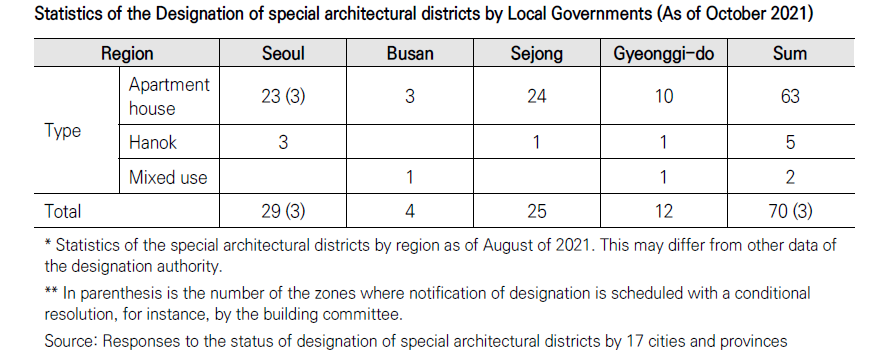
An analysis of the special provisions applied to 58 special architectural districts where deliberation data was available showed that the most common cases were exemptions from the standard on building distance according to Article 61 of the Building Act, Limits on Heights of Buildings for Solar Access, accounting for 57 locations (81.4%). The other cases include exemptions from the Regulations on Housing Construction Standards, and other regulations, prescribed by Presidential Decree pursuant to Article 35 of the Housing Act, accounting for 15 cases (21.4%); exemptions from Article 56, the Floor Area Ratio, of the Building Act, at 11 cases (15.7%); and exemptions from Article 58, Vacant Lot Within the Building Site, at 10 cases (14.3%).
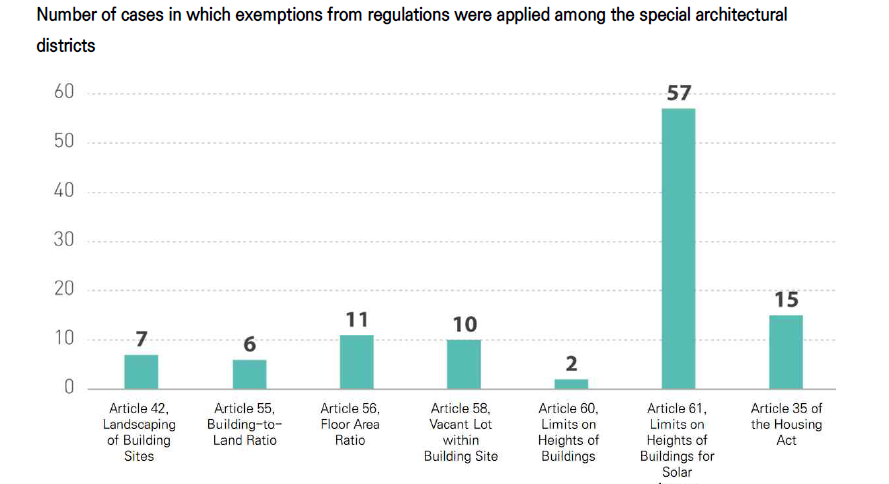
Among the designated special architectural districts, attempts have been made to apply excellent designs, such as securing openness of buildings, forming a harmonious landscape, ensuring a skyline harmonized with the local context, creating various types of building shapes, diversifying flat households, and differentiating façade designs. In addition, in a number of apartment housing cases, attempts were made to secure public access and use by connecting the boundary of the house area with the surrounding area or by opening community facilities to the local residents.
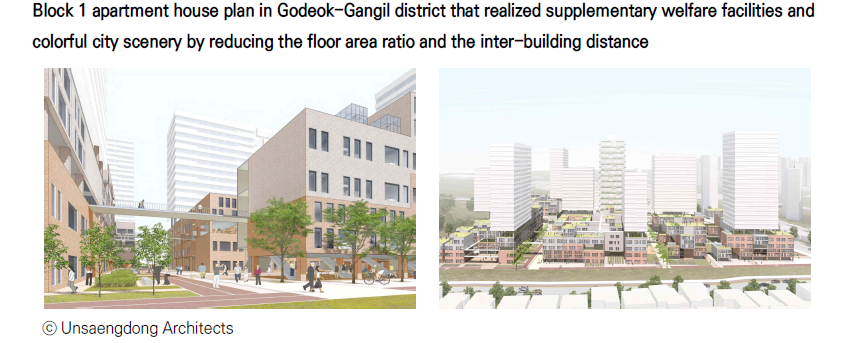
Revision of laws to revitalize the special architectural district system
The special architectural district system has been continuously revised since its establishment in 2007. To promote the special architectural district system and the supply of housing in a creative manner, the authority to apply for designation of a special architectural district has been diversified and cases subject to regulation exemptions have been expanded.
On January 14, 2014, with the revision of the Building Act, those designated as mayors and province governors were added to the designation authority list in addition to the Minister of Land, Infrastructure and Transport. In addition, the expansion of the conditions to meet when applying for a special exemption to the regulations was changed. In the revision of the Building Act on February 3, 2016, prohibited areas for the designation of special architectural districts were reduced by deleting military bases and military facility protection zones from the list. Also, Article 56, the Floor Area Ratio section of the Building Act, was listed in the exemption conditions for special architectural districts. On April 7, 2020, the Building Act was amended to allow persons other than a designated application agency to propose the designation of a special architectural district to the mayor or province governor having jurisdiction over the project zone (Article 71(2), newly established), and on January 8, 2021, a new designation proposal procedure for special architectural districts was established (Article 107-2) by amending the enforcement degree. On January 8, 2021, with the amendment of the Building Act Enforcement Decree, buildings subject to special provisions were eased, with the requirement moving from 300 apartment units to 100 units or more, from 50 hanok buildings to 10 units or more, and to 30 units or more for houses other than the hanok type.
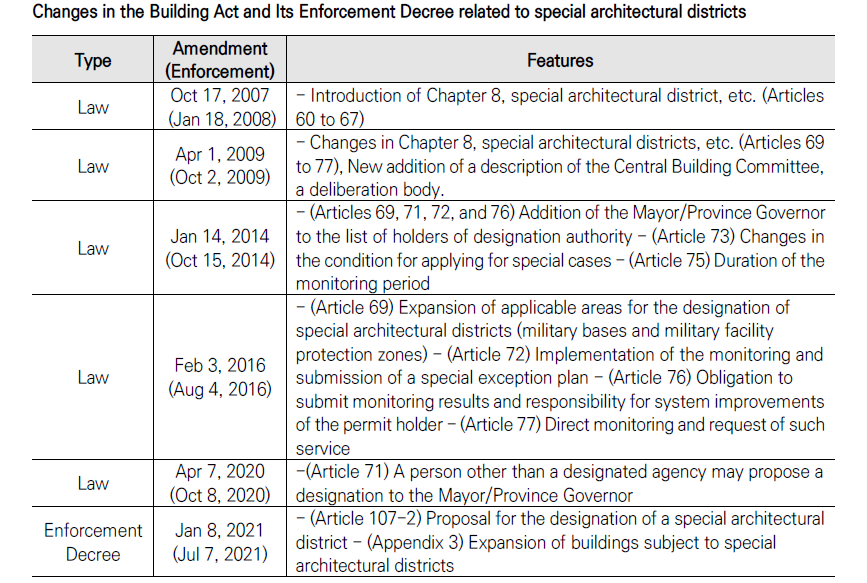
When the system was introduced, it was designed as a system to carry out pilot projects led by the public sector, but the operation of the special architectural district system changed greatly after its introduction, including changes in the composition of stakeholder groups due to the introduction of a designation proposal system other than the designated application agencies. Also, in the early days after the introduction of the system, it was mainly applied to projects for new towns or newly developed areas. Soon, as the scope was gradually expanded to apartment houses in established towns and single houses, including the hanok type, the influence of the special architectural districts on the surrounding areas started to grow. Therefore, for the efficient operation of special architectural districts, the principles and directions for proper system operation must be presented, focusing on how to secure nature for the public compared to benefits that can be obtained by applying the system, such as securing additional floor area and increasing the number of households due to the relaxed limit on height for solar access.
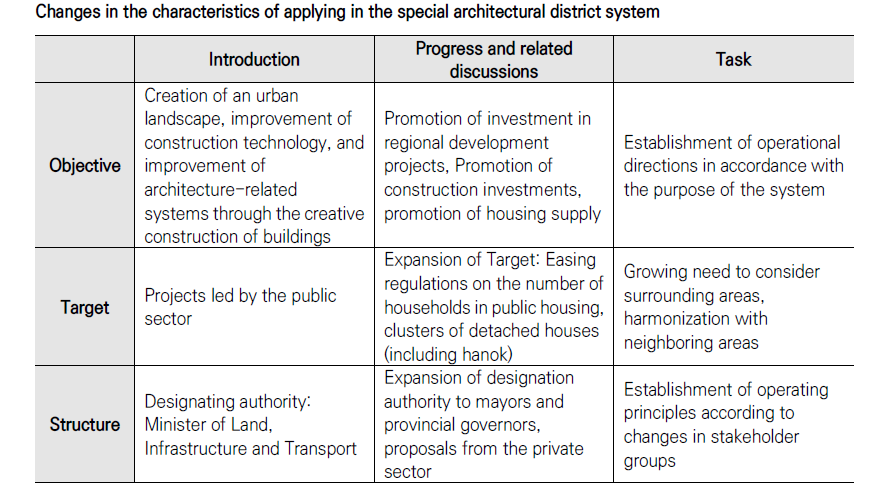
Principles and Direction of Operation of the special architectural district System
Considering the changes in the operational characteristics of the special architectural district system, it is necessary to hear the various opinions from relevant entities, such as the designation authority, designation proposer, and architects in order to set the operating principles and direction of the system. From March 8 to November 3, 2021, the Architecture and Urban Research Institute undertook nine business consultations, four seminars, two hearing sessions to gather opinions from designated agency officials, and ten expert advisory meetings to propose the operating principles and directions of the special architectural district system.
In order to prevent the special architectural district system from negatively affecting the urban environment and surrounding areas, as the system can be used as a means of quantitative easing, it is necessary to apply the following principles with regard to its operation. First, the system should contribute to the promotion of public welfare by improving safety, the functional environment, and the aesthetics of buildings in the special architectural districts. Second, it should realize the public nature of architecture as a living space, as a social element, and as a cultural element. Third, it should create an urban landscape, improve the level of construction technology, and promote improvements of architecture-related systems. Fourth, it should protect the environmental rights of neighboring sites outside of the special architectural district. Lastly, other laws and related plans are to be reviewed in a mutually developing direction. If changes to a previously established plan are necessary, procedures in accordance with related laws should be promptly implemented through prior consultations.
Article 71 (4) of the Building Act stipulates that when designating a special architectural district, the necessity, feasibility, and publicity of the designation should be reviewed. First, in order to meet the requirements for zone designation, the zone in question must be a project zone that can be designated by the Minister of Land, Infrastructure and Transport or a Mayor/Province Governor pursuant to Article 69 of the Act. In addition, the system can be applied when the designation authority deems it necessary to designate a special architectural district, when it is necessary to hold an international event, to improve the landscape, or to create a creative building for the promotion of architectural culture, and when it is necessary to improve the building system or to develop advanced technology for the development of construction technology Next, designation of a zone is justified by reviewing whether the relationship between the upper level and related plans was evaluated. This refers to cases in which the connection and consistency with the surrounding development plans and urban plans are reviewed and reflected in the plan, or where the zone is expected to promote sustainable urban development by adjusting the existing city/county management plan. Lastly, public benefits related to the designation can be evaluated by three categories of criteria pursuant to Articles 7 to 9 of the Framework Act on Building: the benefit as a living space to create architecture and spaces for safe living, that as a social element to solve social problems for a sustainable future, and that as a cultural element related to creative and harmonious architectural designs.
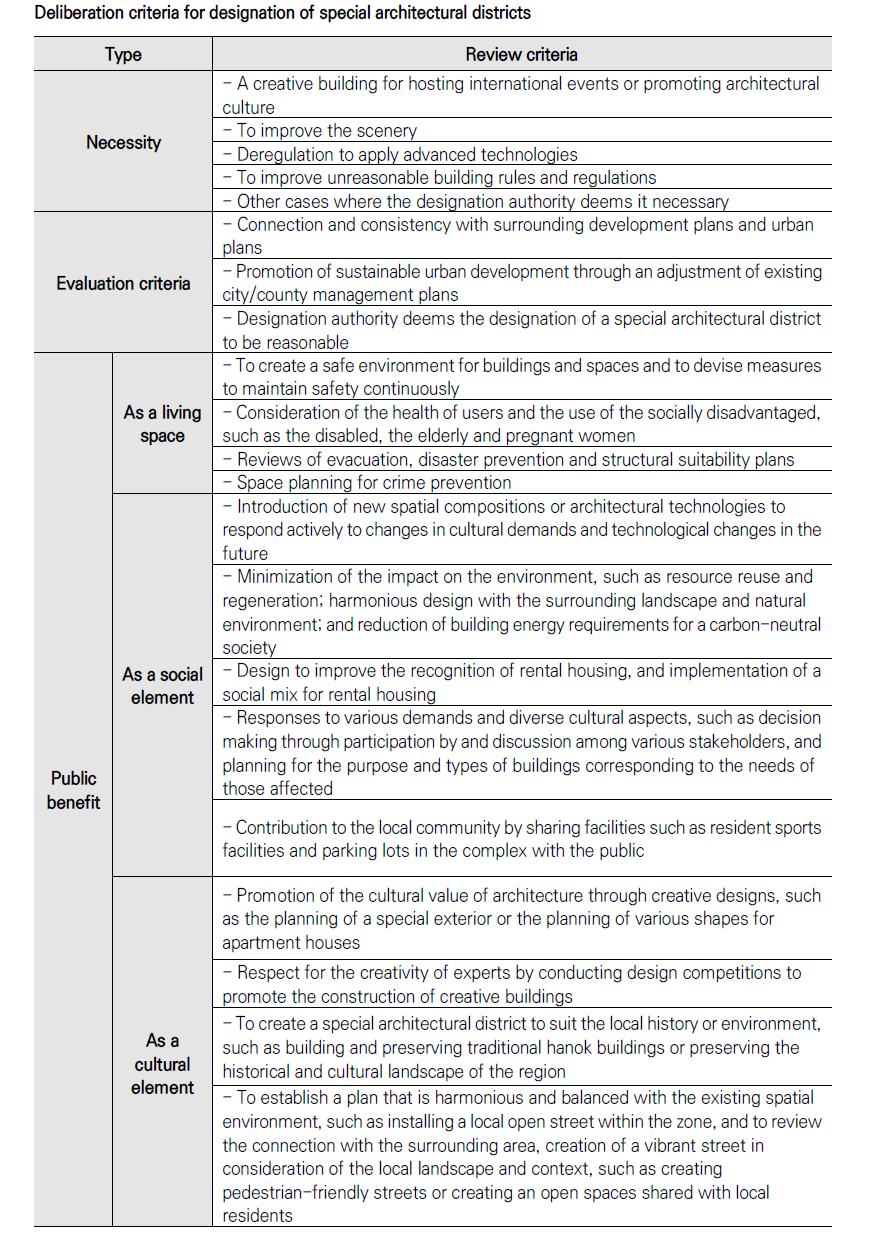
Regulations pertaining to special architectural districts are divided into exemption, relaxation, and integrated applications. In order to apply the exemption criterion, the applicant must describe the reason for the exemption and the expected effects. The designation authority must consider consistency with the higher-level plan, harmony with the surrounding environment, and whether the environmental rights of neighboring sites outside of the zone are violated. The condition of relaxation is to prove equivalent or higher performance compared to that before the relaxation of the relevant regulations. If the regulations are to be applied by integrating them, the relevant facilities must be installed at the same or higher standard than the individual installation standards.
Future Tasks for the Efficient Operation of the special architectural district System
The principles and directions of the operation of the special construction zones described above were reflected in the special architectural district Operation Guidelines after consultations and reviews with the Ministry of Land, Infrastructure and Transport. The guidelines include general rules, operations, procedures for designation and deliberation, evaluation criteria for designation, criteria for special applications of buildings, criteria for integrated applications of buildings, and management after designation as promulgated by order of the Ministry of Land, Infrastructure and Transport.
The special architectural district system is actively discussed as a means of deregulation to promote a better housing supply. In 2021 and 2022, the local government of Seoul designated reconstruction and redevelopment project zones in Jamsil and Sadang-dong as special architectural districts so that building regulations such as the floor area ratio and height limitation could be relaxed while considering regional characteristics. The campaign promises of the new president-elect also called for relaxation of building regulations to activate redevelopment, reconstruction, and remodeling to revitalize the maintenance of small-sized single- and multi-family houses.
If the special architectural district system introduced for harmonious and creative architecture of buildings is abused as a means of quantitative easing, risks include the worsening of the urban landscape and violations of the environmental rights of neighboring residents. When a special architectural district is designated as suggested in this article, a close evaluation of necessity, feasibility, and the public benefit should be made. In the future, it is expected that various cases will be attempted that meet the purpose of the special architectural district system: creations of urban landscapes, improvements of construction technologies, and improvements of architecture-related systems.
- The People Power Party. (2022). Campaign promises of the People Power Party for the 20th presidential election, New Republic of Korea made with fairness and common sense
- Ministry of Land, Infrastructure and Transport. (2021). Public-led 3080+ plan to dramatically expand housing supply in metropolitan areas. Press release on March 4th.
- Seoul Metropolitan City (2022). Seoul City to designate the 5th district of Sadang, an old low-rise residential area, as a special architectural district to make 507 apartment units. Press release on January 14.
- Lim Yookyoung, Lee Jookyung & Kim Junlae. (2021). Establishing operational guidelines for special architecture district. Architecture & Urban Research Institute.
- Notice of designation of the special architectural district for the reconstruction project of Jamsil Miseong Clover Apartment at Jamsil Apartment District, Seoul Metropolitan City No. 2021-700. December 6, 2021.
- Guidelines for Operation of Special Architectural Districts. Ministry of Land, Infrastructure and Transport Ordinance No. 1445. November 3, 2021.
